| Columns Retired Columns & Blogs |
Those speaker measurements appear downright scary.
When a loudspeaker is measured, the underlying assumption is that the distance from the speaker to the microphone is significantly greater than the largest dimension of the speaker's drive-unit array. With conventional moving-coil loudspeakers, this assumption is almost always correct: The microphone is in the speaker's farfield, where any differences in the path lengths from all the drive-units are negligible. However, with a panel loudspeaker such as the Magnepan LRS, this becomes difficult to arrange. The LRS's Magneplanar panel is 38" tall by 10" wide, which means that, at my usual microphone distance of 50", the farfield assumption is incorrect. The resulting proximity effect will tilt up the response at low frequencies—as it will when the loudspeaker is listened to at the same distance.
So with that caveat, I used DRA Labs' MLSSA system and a calibrated DPA 4006 microphone to measure the Magnepan LRS's frequency response in the farfield and an Earthworks QTC-40 mike for the nearfield response.
Magnepan specifies the LRS's sensitivity as 86dB at 500Hz with 2.83V. I don't like specifying a sensitivity at just one frequency, as this could be misleading with a speaker having a nonflat response (as they all do). I prefer to use a wideband noise signal and a B-weighting filter; this filter reduces the effect on the measured value with speakers having extended highs or lows. Taken in this manner, my estimate of the Magnepan's sensitivity was almost 6dB lower than specified, at 80.1dB(B)/2.83V/m. Because a panel speaker has a dipolar radiation pattern, this sensitivity can't be directly compared with that of a conventional box speaker—the dipole emits as much sound to its rear as it does to the front. Even so, the LRS will not go very loud with low-powered amplifiers.
Magnepan specifies the LRS's nominal impedance as 4 ohms. My measurement of the speaker's impedance magnitude (fig.1, solid trace) revealed that the LRS behaves more like a 3.33-ohm load, with a minimum value of 2.8 ohms between 400 and 600Hz. However, the electrical phase angle (dotted trace) is very low; the LRS behaves almost like a pure resistance. This loudspeaker will work well with amplifiers that have no problem driving 4-ohm loads.
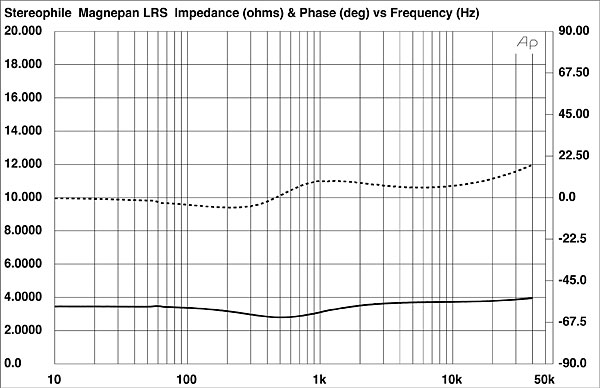
Turning to the LRS's measured frequency response (fig.2), the proximity effect mentioned earlier can be seen. The speaker's farfield output rises as the frequency drops from 500 to 300Hz, while below 300Hz, the response measured in the nearfield rises precipitously. In part, this rise in the midbass will be due to the nearfield measurement technique, which assumes that the drive-units are mounted in a true infinite baffle. But it is also due to the panel's fundamental "drum-skin" resonance, which tends to compensate for the fact that with a dipole speaker the reflections of the speaker's backward-firing sound from the wall behind it will cancel the front-firing sound below a frequency that depends on the panel's size.
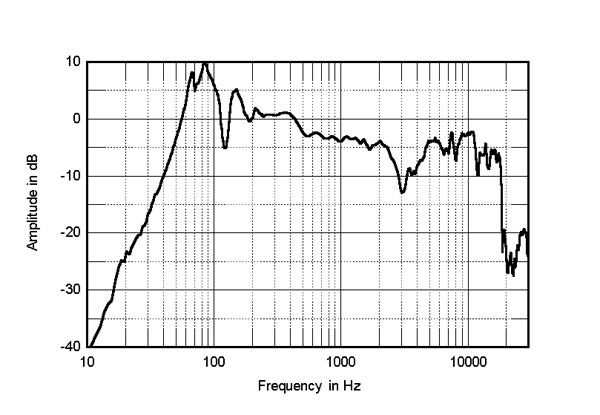
Higher in frequency in fig.2, the black trace shows the Magnepan's farfield response, averaged across a 30° horizontal window centered on the middle of the panel in front of the tweeter section. (With the backward tilt of the panel when supported by its stand, this would be the listening axis.) While the speaker basically offers an even frequency balance from 500Hz to 19kHz, an octave-wide, 7dB-deep suckout in the presence region will both affect the measured sensitivity and make the LRS sound "polite."
However, after I picked up the Maggies from Herb Reichert's Bed-Stuy bunker, he suggested in an email that "When you do your LRS frequency-response measurements—try having the tweeter ribbons 1" farther from the microphone (at 50") than the bass-mid cluster." His cryptic recommendation implied that the presence-region suckout fills in to the side of the tweeter section of the panel—and if you look at the LRS's horizontal dispersion (fig.3), that does appear to be the case. The cursor in this graph is positioned at 3.1kHz, the center frequency of the suckout, and as the individual traces are normalized to the tweeter-axis response, you can see that Herb was correct.
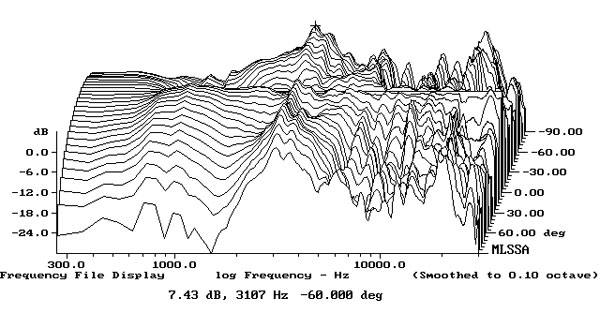
The changes in response on the woofer side of the panel, shown at the front of fig.3, suggest that the listener will get more midrange energy if the speakers are positioned with their tweeter sections on the outside edges. The dipolar behavior in the midrange is evident, though the dispersion in the treble is more complicated. In the vertical plane (fig.4), the suckout at 3.1kHz tends to fill in above and below the midpanel axis.
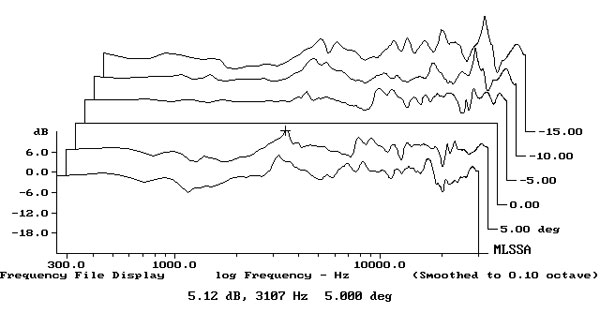
In the time domain, the LRS's step response on the midpanel tweeter axis (fig.5) reveals that the panel's high- and low-frequency sections are connected in positive acoustic polarity. The tweeter step slightly leads that of the woofer on this axis, which suggests that the best blend of the two sections—one that gives a perfect, right-triangle-shaped, time-coincident step—occurs on the woofer side of the measurement axis. Again, Herb's suggestion was correct. Some small high-frequency ripples overlaying the decay of the Magnepan's step give rise to some top-octave hash in the speaker's cumulative spectral-decay plot (fig.6)—but see the link to my measurements of Magnepan's MG2.6/R for an explanation of why this behavior might not matter.
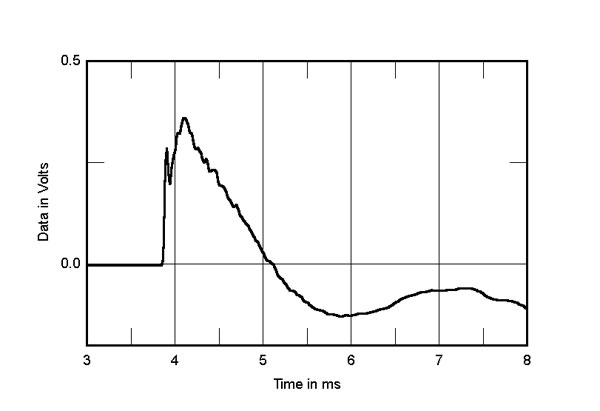
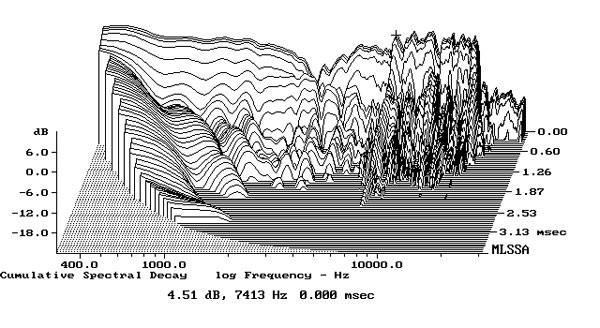
Interpreting the measured performance of a panel loudspeaker such as the Magnepan LRS is far from straightforward. Overall, however, the LRS appears to be capable of well-balanced sound, provided its owner takes care in optimizing such matters as placement and toe-in.—John Atkinson

...try these.
https://www.audiosciencereview.com/forum/index.php?threads/magnepan-lrs-speaker-review.16068/
Granted, they're from the most dismal "review" site online, but it does illustrate how important competence is.

This review seems perfect for one of JA1’s “in room/listening position” frequency response curves!
It would look way cool overlaying the curves for this speaker and the LS 50’s!
Herb: This speakers literally cries out for you to keep it around long term!!!

Excellent idea, Anton ....... As you suggested JA1 could do one of his in-room listening position comparison frequency curves, overlaying LS-50s ......... Also, JA1 could store that curves/information for future reference with other comparatively priced other types of speakers ....... Hope JA1 reads your comments/suggestion ...... Anton, you are a genius :-) .........

If HR likes his Magnepan speakers, HR can keep his Magnepan speakers :-) ........

... inexpensive dipole speakers, then get four of the JBL Stage A170 (available for $170 each) and install them two-per-side and back-to-back in a dipole configuration.
https://www.youtube.com/watch?v=DV2WJ_b1Er0
Also, if HR believes that "even a small upright piano puts more energy into a room than any domestic-use dynamic loudspeaker" then there must be certain domestic-use dynamic loudspeakers (driven by a sufficiently powerful amplifier) that he has yet to experience.

I'm not sure if Wilson WAMM speakers with the accompanying subwoofers could fit into HR's listening room ........ If they do, my guess is that, they could probably put out enough energy into his listening room to resemble a concert grand piano :-) .......

Add .... four D'Agostino Relentless mono-block amps to the above :-) ........

JVS could custom build a 'barn' to house the Wilson WAMMs and the D'Agostino Relentless mono-blocs, and invite us all to listen to Keith Jarrett's version of Bach WTC :-) ..........

Measurements and dipole planars... sigh.
Apparently this Magnepan company knows what they're doing??
LOL..

...and their measurements tend to correlate poorly with their sound. The large radiating area and dipole pattern are complicating factors.

Microphone junkies may not appreciate a speaker with such attributes as this speaker.
It's useful to remember that since they have linesource trebles, they will not exhibit a flatline response: The linesource region's behavior falls off at half the rate of a conventional speaker. The further back, the higher the treble rises. Season to taste.
The little jag in the upper response may be the simple axial behavior of the low-order transfer function between drivers. Also moot where real sound is concerned and again, adjust accordingly.
It's the time behavior where such designs reveal themselves, and sure enough, this speaker's step response is as exceptional as it is rare.

Rendering the measurements almost moot. Waterfall plots from 30 years ago look almost identical to today's measurements.
I've owned several Magneplanars... they sound sublime.

While I love Maggies, the problem with these is that, like their other speakers, there is an added hidden cost since they require boutique dedicated amps that will set you back an arm and a leg to sound their best. These, for example, will not sound their best paired with your typical integrated amp, or even your $1200 Denon AVR.

You are right ....... They are current hungry ......... Look at their impedance measurements :-) ........

The greatest strengths of the panel speakers are, transparency and box-less-ness ........ They are also, time-coincident ........ Those qualities can make them quite addictive :-) .........

What an insult to Maggies, to show them with a cheap Fender acoustic with 4 black bridge pins and two white ones? I love Fender electrics, they're my favorites, but their acoustics are really very poor. Even an entry level Yamaha or Epiphone would have been better, but I would have gone for a nice Martin D28 or D35.

... the Audiophiliac "can just tell" that the combination of the LRS and the new Schiit Ragnarok 2 amplifier "will be magic".
https://www.youtube.com/watch?v=WfeTV7cgZGc

Hopefully HR may review the Ragnarok 2 and tell us how the combination works ....... We can also see the Stereophile measurements of Ragnarok 2 :-) ........

Start saving money to buy the new mid-engine Corvette Stingray with Bose 10 speaker audio system :-) ........

May be HR could reveal that 'secret stereo amp', he writes about in that AXPONA 2019 show report, driving the LRS :-) .........
Could that be a Bryston 3-B/3 stereo amp? :-) ............

and my mind is a sieve, but it might have been a prototype amplifier being developed by Magnepan
hr

Speaker manufacturers developing custom amplifiers to work with their speakers is not a bad idea ....... Vandersteen audio does it for their top models, for example :-) .........

After writing Roger Sanders about the performance of his electrostatic panels (which he will sell to DIY folks) and getting his specs about their performance, I thoroughly understood why he made an amp to drive that highly reactive speaker.
If you think that you need a special amp to power an inefficient speaker that acts as an almost purely resistive, 4 Ohm load, you have absolutely no understanding about speakers or amps.
There is nothing easier for any amp to drive than a purely resistive load. Any decent amp that can pump out 100 or so clean watts will work great with this speaker.
Of course, I do not expect people who pay $5K for a magic power cord to know any of this.
One more thought: perhaps, to judge speakers, you want to use music recorded in the last 20 or 30 years. I don't care whether it's been remastered. Many of the songs listed for listening were of dubious quality and from before I was born in 1959. Few are what I'd consider hi-fi.
The reason I'm seriously considering buying four of these as surround speakers is because of JA's measurements, not how a Fats Domino record sounds on them.
Honestly, Fats Domino? How lame.

"When I get to New Orleans, I want to see the Zulu King
I'm gonna stay right there till I see the Zulu Queen" :-) .........

I got my pair yesterday after almost a 3 month wait due to demand. Out of the box, without any break in, they sound amazing!!! Soundstage is fantastic! Bass is much better than I expected even though eventually I will use them with a subwoofer. I cant imagine what I'll get out of them after a few weeks of use. These are highly recommended. I don't believe there is anything out there that can compete with them at the $650 price.

Good to see J.A. do a speaker test that does not fit the normal process.
Well done J.A. Very impressed with the effort required to test this type of speaker.
Was worried that you might slack off now that semi-retired. This is why I subscribe to and put so much trust in Stereophile's test reports.

I bought a pair of these to experience the ribbon speaker sound and hopefully understand the hype. I get it. These are magic! in the right context. What an insane value, just have a set lying around to use in the right moments. I've had transcendent listening sessions with these. It's not going to be heavy and hard driving music that will make the a memorable session, when the volume is medium and you aren't trying to push audiophile limits these speakers are insane in what they do. I have power cords that cost 10X as much as these speakers and I am so impressed. They need some power, I get pretty good results with a pass 30.8, they shut down my Naim Nova at medium-ish levels. 650 bucks really??? Everyone should have a pair of these just to understand. I might have to take them up on their trade up program